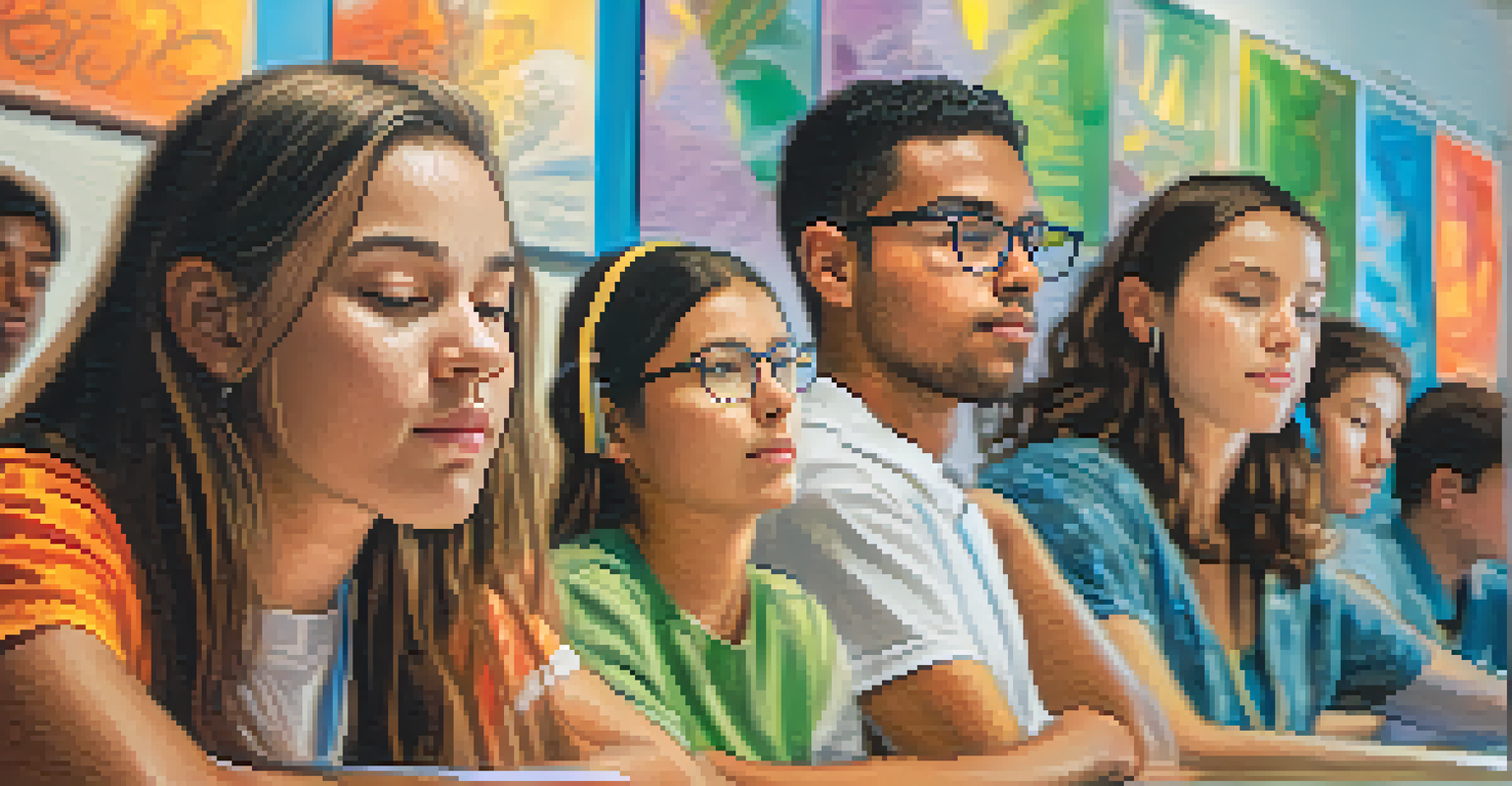Mindfulness and Communication Skills in Education

Understanding Mindfulness in Educational Settings
Mindfulness is the practice of being present and fully engaged in the moment. In educational settings, it encourages students to focus on their thoughts, feelings, and surroundings without judgment. This heightened awareness can lead to improved attention and emotional regulation, which are crucial for effective communication.
Mindfulness isn’t difficult. What’s difficult is to remember to be mindful.
When students practice mindfulness, they learn to listen actively, a skill that is essential for meaningful interactions. They become more aware of their own body language and the non-verbal cues of their peers. This increased awareness fosters a more respectful and empathetic communication environment in the classroom.
Furthermore, teachers who incorporate mindfulness into their classrooms can create a more supportive atmosphere. By modeling these practices, educators can help students develop their emotional intelligence, which plays a significant role in enhancing communication skills. Thus, mindfulness serves as a foundation for better interactions among students and teachers alike.
The Link Between Mindfulness and Effective Communication
Effective communication requires more than just speaking clearly; it involves active listening and emotional awareness. Mindfulness cultivates these essential skills by encouraging individuals to pause and reflect before responding. This pause can prevent misunderstandings and promote thoughtful dialogue.

For instance, when a student practices mindfulness, they might take a moment to breathe and consider their response during a discussion. This not only helps them articulate their thoughts better but also allows them to acknowledge and validate their classmates’ perspectives. Such practices lead to deeper connections and a more collaborative learning experience.
Mindfulness Boosts Student Focus
Practicing mindfulness helps students improve their attention and emotional regulation, leading to better communication.
Moreover, as students become more mindful, they are likely to express their emotions in healthier ways. By understanding their own feelings, they can communicate openly and honestly, reducing the likelihood of conflict. In essence, mindfulness acts as a bridge that enhances both interpersonal skills and academic success.
Implementing Mindfulness Practices in the Classroom
Integrating mindfulness into the classroom can be simple and effective. Teachers can start with brief mindfulness exercises, such as guided breathing or meditation, at the beginning of each class. These moments set a calm tone and prepare students for focused learning and communication.
The mind is everything. What you think you become.
Another approach is to incorporate mindfulness into group activities. For example, during discussions, students can practice 'active listening' by summarizing what their peers have said before sharing their thoughts. This not only reinforces understanding but also shows respect for others' viewpoints, thereby enhancing communication skills.
Additionally, creating a mindful classroom environment can significantly impact student interactions. This can include using calming colors, providing quiet spaces, or even integrating nature into the classroom. Such elements create a supportive atmosphere where students feel safe to express themselves, leading to richer, more effective communication.
Benefits of Mindfulness on Student Relationships
Mindfulness not only enhances communication skills but also strengthens relationships among students. When individuals practice mindfulness, they develop greater empathy and compassion, which are essential for building strong connections. This emotional bonding can create a more cohesive classroom community.
For example, students who engage in mindfulness exercises are more likely to approach conflicts with a calm mindset. This allows them to resolve disagreements amicably, fostering a collaborative spirit. As a result, classrooms become spaces of support where students feel valued and understood.
Empathy Enhances Classroom Bonds
Mindfulness fosters empathy among students, strengthening relationships and creating a supportive classroom community.
Furthermore, these improved relationships extend beyond the classroom. Mindful students often carry these skills into their interactions with family and friends, leading to healthier communication patterns in all areas of their lives. This holistic development is one of the most significant benefits of integrating mindfulness into education.
Mindfulness Techniques to Enhance Communication Skills
There are various mindfulness techniques that can specifically enhance communication skills. One effective technique is 'mindful listening,' which involves giving full attention to the speaker without formulating a response while they talk. This practice allows for deeper understanding and makes the speaker feel heard.
Another technique is 'reflective journaling,' where students write about their feelings and thoughts after discussions or interactions. This process encourages self-reflection and helps students articulate their emotions better in future conversations. It’s a powerful way to connect their inner experiences with external communication.
Lastly, role-playing exercises can also be beneficial. By acting out different scenarios, students can practice communication skills in a safe environment. This experiential learning fosters confidence and prepares them to navigate real-life conversations with mindfulness and empathy.
Challenges in Integrating Mindfulness in Education
While the benefits of mindfulness in education are clear, integrating these practices can come with challenges. One common hurdle is the misconception that mindfulness is merely a relaxation technique. In reality, it requires consistent practice and commitment from both educators and students.
Another challenge is the time constraint in an already packed curriculum. Teachers may feel they lack the time to incorporate mindfulness exercises without sacrificing academic content. However, even short mindfulness moments can yield significant benefits and can be seamlessly integrated into existing lesson plans.
Simple Techniques for Mindful Learning
Integrating brief mindfulness exercises and active listening into lessons can significantly enhance communication skills.
Additionally, some students may resist mindfulness practices due to unfamiliarity or skepticism. It’s crucial for educators to create a safe and open environment where students feel comfortable exploring mindfulness. By fostering a positive attitude towards these practices, they can gradually overcome resistance and reap the rewards.
The Future of Mindfulness and Communication in Education
As the educational landscape continues to evolve, the importance of mindfulness in developing communication skills will likely grow. More schools are recognizing the value of social-emotional learning, which includes mindfulness practices as a core component. This shift can lead to more balanced and holistic educational approaches.
Furthermore, with the increasing prevalence of technology in education, mindfulness can serve as a counterbalance to distraction. By teaching students to focus and engage with their surroundings, educators can empower them to communicate more effectively, even in a digital world.

Ultimately, the future of education may very well hinge on the integration of mindfulness and communication skills. As educators prioritize these practices, they are not just enhancing academic success but also nurturing emotionally intelligent individuals who can navigate the complexities of life with grace and understanding.